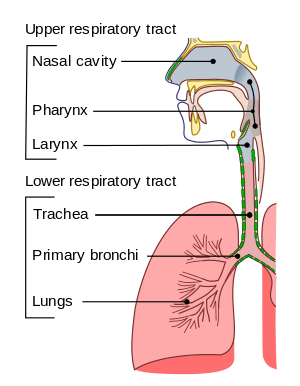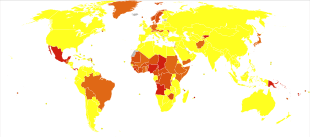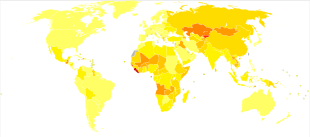Upper respiratory tract infection
| Upper respiratory tract infection | |
|---|---|
 | |
| Conducting passages. | |
| Specialty | Infectious disease |
| Frequency | 17.2 billion (2015)[1] |
| Deaths | 3,100[2] |
Upper respiratory tract infections (URTI) are illnesses caused by an acute infection which involves the upper respiratory tract including the nose, sinuses, pharynx or larynx. This commonly includes nasal obstruction, sore throat, tonsillitis, pharyngitis, laryngitis, sinusitis, otitis media, and the common cold.[3] Most infections are viral in nature and in other instances the cause is bacterial.[4] Upper respiratory tract infections can also be fungal or helminth in origin, but these are far less common.[5]
In 2015, 17.2 billion cases of upper respiratory infections were recorded.[1] As of 2014, upper respiratory infections caused about 3,000 deaths down from 4,000 in 1990.[6]
Classification
A URI may be classified by the area inflamed. Rhinitis affects the nasal mucosa, while rhinosinusitis or sinusitis affects the nose and paranasal sinuses, including frontal, ethmoid, maxillary, and sphenoid sinuses. Nasopharyngitis (rhinopharyngitis or the common cold) affects the nares, pharynx, hypopharynx, uvula, and tonsils generally. Without involving the nose, pharyngitis inflames the pharynx, hypopharynx, uvula, and tonsils. Similarly, epiglottitis (supraglottitis) inflames the superior portion of the larynx and supraglottic area; laryngitis is in the larynx; laryngotracheitis is in the larynx, trachea, and subglottic area; and tracheitis is in the trachea and subglottic area.
Signs and symptoms

In uncomplicated colds, cough and nasal discharge may persist for 14 days or more even after other symptoms have resolved.[4] Acute upper respiratory tract infections include rhinitis, pharyngitis/tonsillitis and laryngitis often referred to as a common cold, and their complications: sinusitis, ear infection and sometimes bronchitis (though bronchi are generally classified as part of the lower respiratory tract.) Symptoms of URTIs commonly include cough, sore throat, runny nose, nasal congestion, headache, low-grade fever, facial pressure and sneezing.
Symptoms of rhinovirus in children usually begin 1–3 days after exposure. The illness usually lasts 7–10 more days.[4]
Color or consistency changes in mucous discharge to yellow, thick, or green are the natural course of viral upper respiratory tract infection and not an indication for antibiotics.[4]
Group A beta hemolytic streptococcal pharyngitis/tonsillitis (strep throat) typically presents with a sudden onset of sore throat, pain with swallowing and fever. Strep throat does not usually cause runny nose, voice changes, or cough.
Pain and pressure of the ear caused by a middle ear infection (otitis media) and the reddening of the eye caused by viral conjunctivitis are often associated with upper respiratory infections.
Cause
In terms of pathophysiology, rhino virus infection resembles the immune response. The viruses do not cause damage to the cells of the upper respiratory tract but rather cause changes in the tight junctions of epithelial cells. This allows the virus to gain access to tissues under the epithelial cells and initiate the innate and adaptive immune responses.[7]
Up to 15% of acute pharyngitis cases may be caused by bacteria, most commonly Streptococcus pyogenes, a group A streptococcus in streptococcal pharyngitis ("strep throat").[8] Other bacterial causes are Streptococcus pneumoniae, Haemophilus influenzae, Corynebacterium diphtheriae, Bordetella pertussis, and Bacillus anthracis.
Sexually transmitted infections have emerged as causes of oral and pharyngeal infections.[9]
Diagnosis
| Symptoms | Allergy | URI | Influenza |
|---|---|---|---|
| Itchy, watery eyes | Common | Rare (conjunctivitis may occur with adenovirus) | Soreness behind eyes, sometimes conjunctivitis |
| Nasal discharge | Common | Common[4] | Common |
| Nasal congestion | Common | Common | Sometimes |
| Sneezing | Very common | Very common[4] | Sometimes |
| Sore throat | Sometimes (post-nasal drip) | Very common[4] | Sometimes |
| Cough | Sometimes | Common (mild to moderate, hacking)[4] | Common (dry cough, can be severe) |
| Headache | Uncommon | Rare | Common |
| Fever | Never | Rare in adults, possible in children[4] | Very common 100–102 °F (or higher in young children), lasting 3–4 days; may have chills |
| Malaise | Sometimes | Sometimes | Very common |
| Fatigue, weakness | Sometimes | Sometimes | Very common (can last for weeks, extreme exhaustion early in course) |
| Muscle pain | Never | Slight[4] | Very common (often severe) |
Prevention
There is low or very-low quality evidence that probiotics may be better than placebo in preventing acute URTIs.[10] Vaccination against influenza viruses, adenoviruses, measles, rubella, Streptococcus pneumoniae, Haemophilus influenzae, diphtheria, Bacillus anthracis, and Bordetella pertussis may prevent them from infecting the URT or reduce the severity of the infection.
Treatment

The Centers for Disease Control describe protocol for treating sinusitis while at the same time discouraging overuse of antibiotics:
- Target likely organisms with first-line drugs: Amoxicillin, Amoxicillin/Clavulanate
- Use shortest effective course: Should see improvement in 2–3 days. Continue treatment for 7 days after symptoms improve or resolve (usually a 10–14 day course).
- Consider imaging studies in recurrent or unclear cases: some sinus involvement is frequent early in the course of uncomplicated viral URI[4]
Treatment comprises symptomatic support usually via analgesics for headache, sore throat and muscle aches.[11] Moderate exercise in sedentary subjects with naturally acquired URTI probably does not alter the overall severity and duration of the illness.[12] No randomized trials have been conducted to ascertain benefits of increasing fluid intake.[13]
Antibiotics
Prescribing antibiotics for laryngitis is not suggested practice.[14] The antibiotics penicillin V and erythromycin are not effective for treating acute laryngitis.[14] Erythromycin may improve voice disturbances after one week and cough after two weeks, however any modest subjective benefit is not greater than the adverse effects, cost, and the risk of bacteria developing resistance to the antibiotics.[14] Health authorities have been strongly encouraging physicians to decrease the prescribing of antibiotics to treat common upper respiratory tract infections because antibiotic usage does not significantly reduce recovery time for these viral illnesses.[14] Decreased antibiotic usage could also have prevented drug resistant bacteria. Some have advocated a delayed antibiotic approach to treating URIs which seeks to reduce the consumption of antibiotics while attempting to maintain patient satisfaction. Most studies show no difference in improvement of symptoms between those treated with antibiotics right away and those with delayed prescriptions.[15] Most studies also show no difference in patient satisfaction, patient complications, symptoms between delayed and no antibiotics. A strategy of "no antibiotics" results in even less antibiotic use than a strategy of "delayed antibiotics".[15]
Decongestants

According to a Cochrane review, single oral dose of nasal decongestant in the common cold is modestly effective for the short term relief of congestion in adults; however, "there is insufficient data on the use of decongestants in children." Therefore, decongestants are not recommended for use in children under 12 years of age with the common cold.[15] Oral decongestants are also contraindicated in patients with hypertension, coronary artery disease, and history of bleeding strokes.[17][18]
Over-the-counter cough medicine
There is no good evidence supporting the effectiveness of over-the-counter cough medications for reducing coughing in adults or children.[19] Children under 2 years old should not be given any type of cough or cold medicine due to the potential for life-threatening side effects.[20] In addition, according to the American Academy of Pediatrics, the use of cough medicine to relieve cough symptoms should be avoided in children under 4 years old, and the safety is questioned for children under 6 years old.[21]
Alternative medicine
Routine supplementation with vitamin C is not justified, as it does not appear to be effective in reducing the incidence of common colds in the general population.[22] The use of vitamin C in the inhibition and treatment of upper respiratory infections has been suggested since the initial isolation of vitamin C in the 1930s. Some evidence exists to indicate that it could be justified in persons exposed to brief periods of severe physical exercise and/or cold environments.[22] Given that vitamin C supplements are inexpensive and safe, people with common colds may consider trying vitamin C supplements in order to assess whether they are therapeutically beneficial in their case.[22]
There is low-quality evidence indicating that the use of nasal irrigation with saline solution may alleviate symptoms in some people.[23] There are also saline nasal sprays which can be of benefit.
Epidemiology
Children have 2-9 viral respiratory illnesses per year.[4] In 2013 18.8 billion cases of upper respiratory infections were reported.[24] As of 2014, upper respiratory infections caused about 3,000 deaths down from 4,000 in 1990.[6] In the United States, URIs are the most common infectious illness in the general population. URIs are the leading reasons for people missing work and school.
See also
References
- 1 2 GBD 2015 Disease and Injury Incidence and Prevalence, Collaborators. (8 October 2016). "Global, regional, and national incidence, prevalence, and years lived with disability for 310 diseases and injuries, 1990–2015: a systematic analysis for the Global Burden of Disease Study 2015". Lancet. 388 (10053): 1545–1602. doi:10.1016/S0140-6736(16)31678-6. PMC 5055577. PMID 27733282.
- ↑ GBD 2015 Mortality and Causes of Death, Collaborators. (8 October 2016). "Global, regional, and national life expectancy, all-cause mortality, and cause-specific mortality for 249 causes of death, 1980–2015: a systematic analysis for the Global Burden of Disease Study 2015". Lancet. 388 (10053): 1459–1544. doi:10.1016/s0140-6736(16)31012-1. PMC 5388903. PMID 27733281.
- ↑ Pokorski 2015, p. 28.
- 1 2 3 4 5 6 7 8 9 10 11 12 "Rhinitis Versus Sinusitis in Children" (PDF). Centers for Disease Control and Prevention. Archived (PDF) from the original on 16 February 2017. Retrieved 19 December 2016.

- ↑ Heymann 2015, pp. 443–445.
- 1 2 Lozano, R; Naghavi, M; Foreman, K; Lim, S; Shibuya, K; Aboyans, V; Abraham, J; Adair, T; Aggarwal, R; Ahn, SY; Alvarado, M; Anderson, HR; Anderson, LM; Andrews, KG; Atkinson, C; Baddour, LM; Barker-Collo, S; Bartels, DH; Bell, ML; Benjamin, EJ; Bennett, D; Bhalla, K; Bikbov, B; Bin Abdulhak, A; Birbeck, G; Blyth, F; Bolliger, I; Boufous, S; Bucello, C; et al. (15 December 2012). "Global and regional mortality from 235 causes of death for 20 age groups in 1990 and 2010: a systematic analysis for the Global Burden of Disease Study 2010". Lancet. 380 (9859): 2095–128. doi:10.1016/S0140-6736(12)61728-0. PMID 23245604.
- ↑ Pokorski 2015, p. 27.
- ↑ Bisno, AL. Acute pharyngitis. N Engl J Med. 2001;344:205. doi:10.1056/nejm200101183440308. PMID 11172144.
- ↑ "Human papillomavirus (HPV) and Oropharyngeal Cancer, Sexually Transmitted Diseases". Centers for Disease Control and Prevention. 4 November 2016. Archived from the original on 16 December 2016. Retrieved 19 December 2016.
- ↑ Hao, Q; Dong, BR; Wu, T (3 February 2015). Dong, Bi Rong, ed. "Probiotics for preventing acute upper respiratory tract infections". Cochrane Database of Systematic Reviews. 9 (2): CD006895. doi:10.1002/14651858.CD006895.pub3. PMID 25927096.
- ↑ "Common Cold: Treatments and Drugs". Mayo Clinic. Archived from the original on 12 February 2010. Retrieved 9 January 2010.
- ↑ Weidner T, Schurr T (August 2003). "Effect of exercise on upper respiratory tract infection in sedentary subjects". Br J Sports Med. 37 (4): 304–6. doi:10.1136/bjsm.37.4.304. PMC 1724675. PMID 12893713.
- ↑ Guppy, MP; Mickan, SM; Del Mar, CB (28 February 2004). ""Drink plenty of fluids": a systematic review of evidence for this recommendation in acute respiratory infections". BMJ. 328 (7438): 499–500. doi:10.1136/bmj.38028.627593.BE. PMC 351843. PMID 14988184.
- 1 2 3 4 Reveiz, Ludovic; Cardona, Andrés Felipe (2015-05-23). "Antibiotics for acute laryngitis in adults". The Cochrane Database of Systematic Reviews (5): CD004783. doi:10.1002/14651858.CD004783.pub5. ISSN 1469-493X. PMID 26002823.
- 1 2 3 Spurling GK, Del Mar CB, Dooley L, Foxlee R, Farley R (September 2017). Spurling GK, ed. "Delayed antibiotics for respiratory infections". Cochrane Database of Systematic Reviews: CD004417. doi:10.1002/14651858.CD004417.pub5. PMID 28881007.
- ↑ "Mortality and Burden of Disease Estimates for WHO Member States in 2002" (xls). World Health Organization. 2002. Archived from the original on 16 January 2013.
- ↑ Tietze, KJ (2004). "Disorders related to cold and allergy". In Berardi, Rosemary R. Handbook of Nonprescription Drugs (14th ed.). Washington, DC: American Pharmacists Association. pp. 239–269. ISBN 978-1-58212-050-8. OCLC 56446842.
- ↑ Covington, Timothy R., ed. (2002). "Common cold". Nonprescription Drug Therapy: Guiding Patient Self-care (1st ed.). St Louis, MO: Facts & Comparisons. pp. 743–769. ISBN 978-1-57439-146-6. OCLC 52895543.
- ↑ Smith, Susan M.; Schroeder, Knut; Fahey, Tom (2014-11-24). "Over-the-counter (OTC) medications for acute cough in children and adults in community settings". The Cochrane Database of Systematic Reviews (11): CD001831. doi:10.1002/14651858.CD001831.pub5. ISSN 1469-493X. PMID 25420096.
- ↑ Research, Center for Drug Evaluation and. "Special Features – Use Caution When Giving Cough and Cold Products to Kids". www.fda.gov. Archived from the original on 12 January 2017. Retrieved 23 January 2017.
- ↑ Goldsobel, Alan B.; Chipps, Bradley E. (2010-03-01). "Cough in the pediatric population". The Journal of Pediatrics. 156 (3): 352–358. doi:10.1016/j.jpeds.2009.12.004. ISSN 1097-6833. PMID 20176183.
- 1 2 3 Hemilä, Harri; Chalker, Elizabeth (2013-01-31). "Vitamin C for preventing and treating the common cold". The Cochrane Database of Systematic Reviews (1): CD000980. doi:10.1002/14651858.CD000980.pub4. ISSN 1469-493X. PMID 23440782.
- ↑ King, David; Mitchell, Ben; Williams, Christopher P.; Spurling, Geoffrey K. P. (2015-04-20). "Saline nasal irrigation for acute upper respiratory tract infections". The Cochrane Database of Systematic Reviews (4): CD006821. doi:10.1002/14651858.CD006821.pub3. ISSN 1469-493X. PMID 25892369.
- ↑ Global Burden of Disease Study 2013 Collaborators (22 August 2015). "Global, regional, and national incidence, prevalence, and years lived with disability for 301 acute and chronic diseases and injuries in 188 countries, 1990–2013: a systematic analysis for the Global Burden of Disease Study 2013". Lancet. 386 (9995): 743–800. doi:10.1016/s0140-6736(15)60692-4. PMC 4561509. PMID 26063472.
Bibliography
External links
| Classification |
|---|
- Colds and the Flu – Treatment from FamilyDoctor
- Upper Respiratory Tract Infection from Cleveland Clinic Online Medical Reference